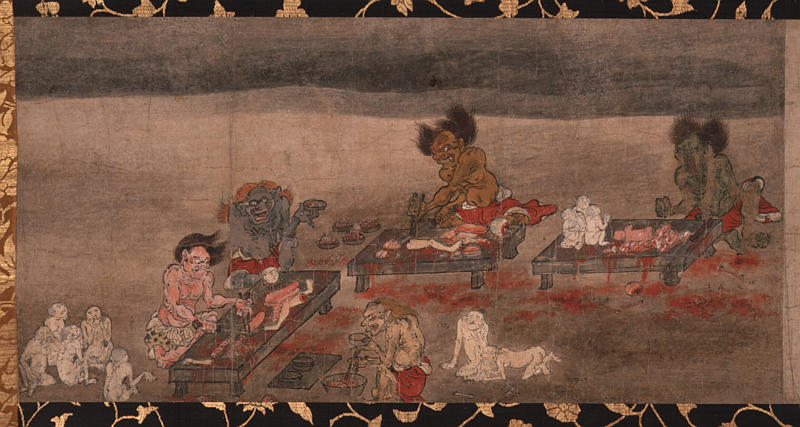沙門地獄草紙 解身地獄
- 鎌倉時代
- 13c
- 紙本著色墨書
- H-26.1 W-90.5
- 所蔵
- 益田家(益田鈍翁)旧蔵
鎌倉時代 13世紀
紙本著色墨書
縦:26.1cm 横:90.5cm
現在断簡となっているこの絵巻は,かつて七図で一巻をなし,戒律を守るべき沙門(僧)でありながら罪を犯した者が堕ちる沙門地獄を描いている。沙門地獄の典拠は,中国唐代に流行した偽経『宝達問報応沙門経』にあり,それによると,東方の鉄囲山中にある無量の地獄の一画に三十二の沙門地獄があるという。この経を取り込んで唐代に成立した十六巻本『仏名経』が,平安時代に,歳末に罪障を懺悔する宮中の行事「仏名会」の典拠となったことで,その内容は当時広く知られていた。
解身地獄は,生き物を殺してその関節をはずした沙門が堕ちるところで,経説では,罪人は鉄桁にかけられ,鋸で関節を切り離され,獣鳥に肉を食われ血を吸われるという残忍な描写がなされるが,詞書は,鬼卒に手足を切られ,関節をはずされ,さらに砂粒のようになるまで切り刻まれるとあり,そして俎を叩いて「活々」と言うと再び人の形に戻り,再び魚のなますのように切り刻まれるという。これは地獄の苦患が無限であることを強調したものである。
図は,上辺に無明の闇を象徴する墨彩の霞をたなびかせ,下方に三つの俎を配して,詞書にしたがって右から時計回りに場面を進めている。詞書にあるなますにヒントを得てこの様子をまるで鬼卒の調理と宴会のような場面として描くのはこの画家の創案で,味見をする羅刹の表情などには一種ユーモラスな趣がある。この左方の包丁と箸を使って肉を切り刻む羅刹の姿は,承久本北野天神縁起巻七の沙門地獄の図にも引き継がれている。
この絵巻を含む,一般に六道絵と一括される作品は,平安後期の六道思想の広まりと,経典の内容に対する説話的興味を背景に制作されたもので,地獄の受苦の様子を,軽快な筆描によって的確に表現することに共通の特色があるが,本図は,視点が引かれ客観的な表現をとること,また説明的な図様構成になっていることで,威圧的な恐怖感は希薄になっていることから,制作は鎌倉時代前期と考えられる。(若杉)
地獄
地獄
地下にある牢獄の意味。苦しみの極まった世界で、現世に悪行を為した者が、死後その報いを受けるところ。罪業の結果として報われた生存状態、および環境である、三悪道、五趣、六道、十界の一つ。
経論のよって種々に説かれるが、無間、八熱(八大)、八寒、孤独などの地獄があり、八大または八寒地獄の一つ一つには十六小地獄(十六遊増す地獄)があり、みな閻浮提の下二万(または三万二千)由旬の所にあると言われる。
(中村 元 「仏教語大辞典」東京書籍 より)
焔摩天像
Catalogue Entry
Kamakura period, 13th century
Hanging scroll, color and ink on paper
Height, 26.1cm; width, 90.5cm
This now-fragmented handscroll was originally made up of seven scenes depicting the Shamon Jigoku, or "hell for priests" (monks) who have committed sins. The text source for this hell for priests was the Hotatsumonhoo-shamon-kyo promulgated in the Tang dynasty, and this text states that in the iron-fenced mountains to the east, there is a boundless hell with 32 hells for priests. This 16-scroll set of the Fo-ming-ching sutra created in the Tang dynasty contains this sutra, and this Fo-ming-ching sutra became the text for the Butsumyoe, one of the annual events held at year's end in the Imperial Palace during the Heian period to repent sins and offenses. Thus the contents of this sutra were widely known during that period.
The hell of dismemberment is the hell for priests who have killed living beings and dismembered their victims. The sutra text depicts the brutal scene of the offenders who were hung from iron beams, their bodies cut up with saws, and then their flesh eaten and their blood drunk by birds and animals. The text that accompanies this painting states that the legs and arms of the victims are cut off by demons, and then the flesh is torn from their bones, and is further ground into dust. Then these demons would strike their cutting boards, shouting "Live! Live!" and the destroyed flesh would reform as humans, all to be dismembered again like so many catfish. This recurring atrocity only helps to emphasize the endless nature of hell.
Here the top of the composition is coated with ink clouds symbolizing the lightless gloom of hell, and in accordance with the accompanying text, the lower half of the composition shows an arrangement of 3 cutting boards, and following the text's description and working clockwise, the various processes of dismemberment are shown. Taking a hint from the catfish imagery mentioned in the text, this scene is depicted as nothing more than a demon's kitchen and banquet, and the artist's creativity adds the humorous touch of the expression on the demon cannibals' faces as they sample the fare. The figure of the demon on the left who uses knives and chopsticks as he carves the meat can also be seen in the image of the Shamon Jigoku from the 7th scroll of the Jokyu version of the Kitano Tenjin Engi.
Including the present scroll, the works that are generally known as images of the Six Paths were created amidst the spread of the Six Paths doctrine during the Heian period and the resulting narrative interest in the sutra contents. These paintings are all characterized by nimble brush-work used to provide detailed renderings of the tortures of hell, and the objectivity that colors this depiction and the compositional arrangement which emphasizes the narrative nature of the text lessen the dominant sense of fear evoked by these horrors, all aspects which suggest an early Kamakura-period date for this work. JW

